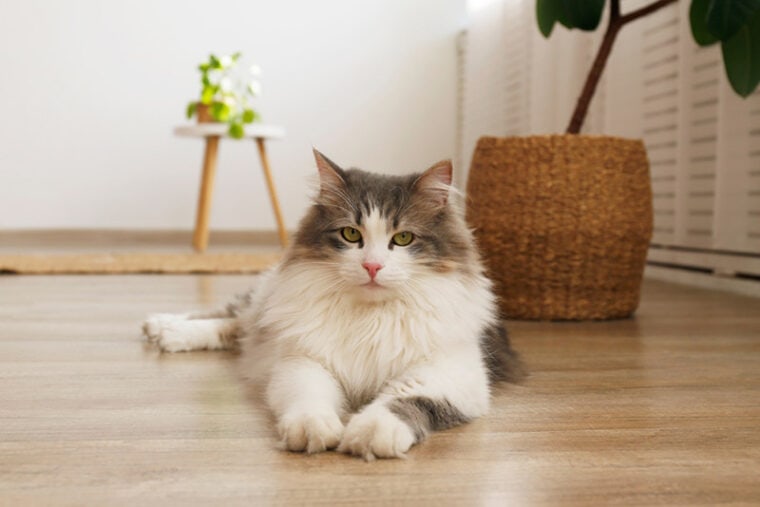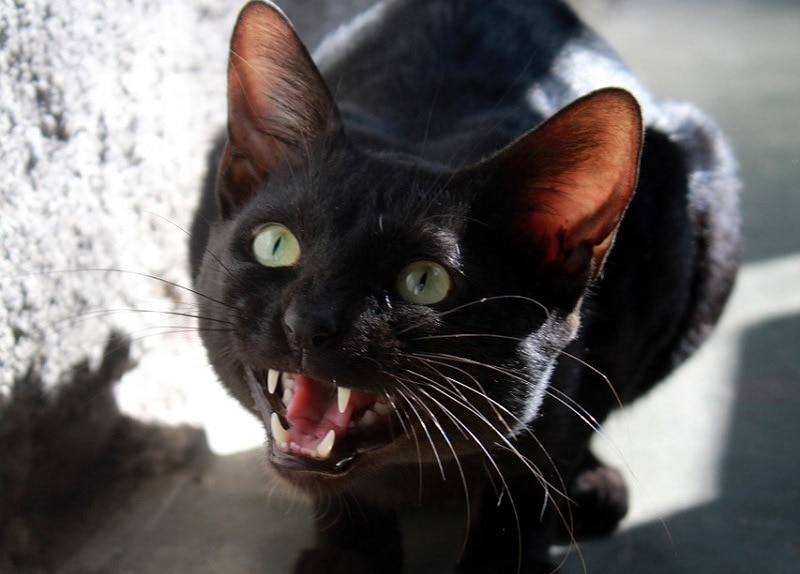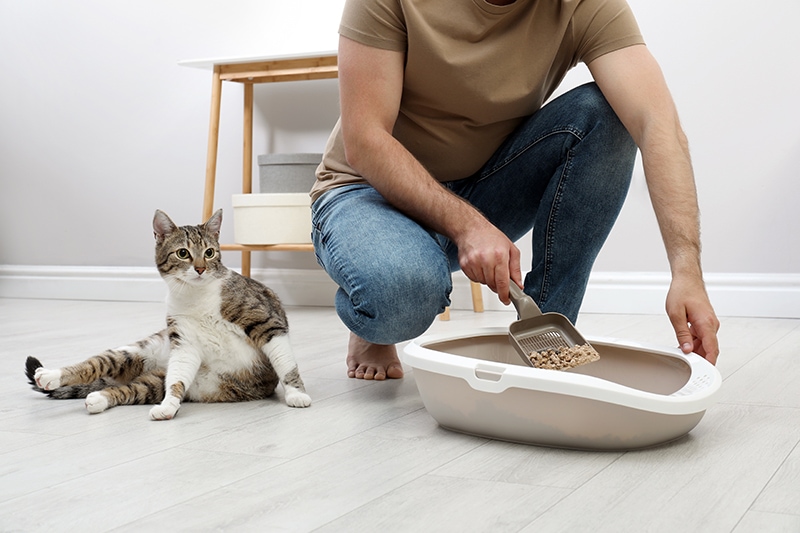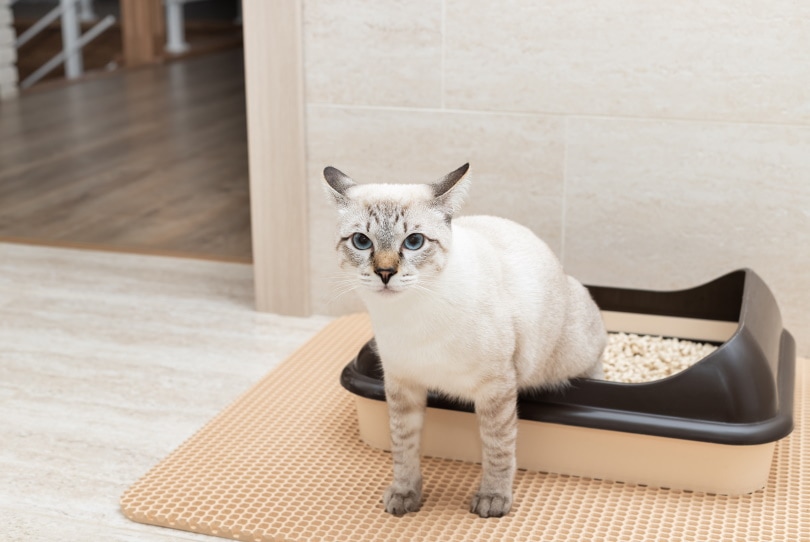
Cats are family members, but sometimes they do things we’d rather they didn’t. Aggression and peeing outside the litter box are some of the most reported feline behavioral problems, often leading owners to seek information on why it is happening and how they can help their cat. Most feline behavioral issues can be addressed with patience and a few tweaks.
But before trying to fix the problem yourself, it’s critical to have your cat checked out by a veterinarian, as aggression and litter box avoidance are often signs of illness, including conditions that can be serious such as urinary tract infections and dental disease. Once your cat has a clean bill of health, you can start trying to identify the cause of the behavior problem so you can come up with an effective strategy to address it.
The 11 Most Common Behavior Problems in Cats
1. Petting-Induced Aggression
Cats can become aggressive towards people while being petted. It occurs when cats suddenly bite while being handled. Veterinarians aren’t sure what causes the reaction, but some cats may be more sensitive to repeated physical contact than others. The repeated stroking of one spot may irritate and annoy cats to the point where they give a warning nip and end the encounter.
Always pay attention to your cat’s reactions while petting them, and be prepared to stop if they begin showing signs of irritation, such as tail twitching or turning their head towards your hand. The situation is best handled by respecting cats’ boundaries and responding to their more subtle requests to be left alone.
2. Fear-Based Aggression
Some cats may become aggressive when extremely frightened, particularly if they feel trapped. Approaching cats that are seriously upset can easily lead to aggression if they feel they’re being closed in on. Signs of fear in cats include dilated pupils, flat ears, tucking the tail, hissing, and growling. Some hold a front paw off the ground as if preparing for defensive actions.
Fear-based aggression can almost always be prevented by allowing frightened cats the time and space to calm down. Leaving the cat alone often is enough to prevent incidents from escalating to aggression. Providing your cat with a safe space where they can stay away from children and pets if they want to can go a long way toward increasing the comfort level of all your family members.

3. Territorial Aggression
Cats exhibit territorial aggression toward other cats and sometimes people. Typical behaviors include stalking, chasing, and attacking, particularly when the target enters the area the cat considers theirs. Indoor cats can become protective of a specific part of the house. The issue often arises when kittens grow into adult cats and new pets are introduced.
Territorial aggression can sometimes be improved by increasing your cat’s sense of comfort, which often includes providing lots of time for them to become accustomed to upcoming changes. But once the problem has started, identifying and removing the trigger should reduce your pet’s sense of being under threat. Once your buddy feels like their old self, the aggression should dissipate.
4. Play-Based Aggression
Play-based aggression is common in kittens—they sometimes become too enthusiastic. It’s normal for kittens to stalk and chase as they learn about the world and their feline abilities. But sometimes, the biting and pouncing cross a line and become too aggressive. The behavior is most often seen in kittens and younger cats.
Cats often become excited for playtime when they have too much pent-up energy. Multiple play sessions throughout the day may help manage your cat’s enthusiasm levels. Stick with teasers and toys designed to give cats something to run after but avoid encouraging cats to chase or pounce on your hands or feet. Providing cats with several toys to keep them entertained and rotating them periodically while you’re away may also help them limit their aggression during human-cat playtime.
5. Pain-Based Aggression
Cats in severe pain sometimes become aggressive, often biting and swatting when touched in painful spots. Many do their very best to avoid being touched or picked up. Cats often hide signs they’re not feeling well, making it difficult to spot early signs of illness.
Cats often become excited for playtime when they have too much pent-up energy. Multiple play sessions throughout the day may help manage your cat’s enthusiasm levels. Stick with teasers and toys designed to give cats something to run after but avoid encouraging cats to chase or pounce on your hands or feet. Providing cats with several toys to keep them entertained and rotate them periodically while you’re away may also help them limit their aggression during human-cat playtime.
6. Litter Box Issues Related to Cleanliness
Cats sometimes avoid going to the litter box when it’s too dirty. They’re notorious for refusing to put their paws in filthy litter boxes. Litter boxes should be scooped out at least once a day, and the litter should be replaced at least once a week. The litter box should be cleaned with hot soapy water regularly, and a bit of diluted vinegar can help eliminate smells.
Avoid using products such as bleach, ammonia, or any other product that could potentially be toxic to cats. Fastidious cats often dislike strong smells, so stay away from strongly scented litter products. You can add a few sprinkles of baking soda for odor control.

7. Litter Box Issues Related to the Litter
Cats are famous for being picky about their toileting habits. They may refuse to enter the box if a new litter has been introduced, and many also avoid brands that irritate their noses or make them sneeze.
You can transition from one litter to another over the course of a few days to make the process easier on your cat. Gradually increase the amount of the new product and use less of the old until the transition is complete. But be prepared to try another product if your cat refuses to cooperate even after a nice long adjustment period, as some dislike the feel of certain litter products. Cats do better with unscented brands and consider using silica-based products, as they often produce less dust.
8. Litter Box Issues Related to Age
Older cats and pets suffering from mobility issues due to illness or joint conditions might pee in strange places because they can’t get to litter boxes that are too far away. If you live in a home with stairs, consider putting a litter box on every floor to make it easier for your cat to make it to the bathroom on time.
An extra litter box in the room where they like to hang out can make a massive difference in older and sick cats’ quality of life. Pets suffering from joint conditions benefit from large litter boxes that give them room to get comfortable. Avoid top entry options that require pets to jump for access. Litter boxes with short walls can make it easier for pets with mobility issues to pee without suffering too much pain.

9. Litter Box Issues Related to Competition
Pets in multi-cat households sometimes avoid using the litter box to prevent confrontations with dominant animals. It’s often seen in combination with food and water guarding. Aggressor cats often engage in bullying behaviors when you’re not around, making the problem sometimes challenging to identify. Cats on the receiving end of the aggression often become withdrawn. Litter box avoidance is also commonly seen.
The problem is sometimes caused by resource competition, particularly when multiple cats share litter boxes and food bowls. To calm things down, ensure that at least one litter box per cat plus one is on hand. Each pet should also have their own food and water bowls. Consider feeding the cats at different times or in separate locations to allow them to dine in peace. Once both cats start feeling comfortable again, things should naturally improve.
10. Spraying
Cat urine is packed full of pheromones that cats use to communicate with each other. When cats spray, they leave information about their physical health, stress levels, and even reproductive status. But it also lets other cats know that a particular area has already been claimed. Male, female, indoor, and outdoor pets all spray. Indoor cats often do so when stressed due to the introduction of new pets. It’s a relatively common response to the arrival of new babies.
Cats generally don’t spray when feeling secure at home. Giving pets plenty of time to adjust to environmental changes can help reduce stress and anxiety that often leads to spraying. Introduce cats to the smells and sounds associated with new babies well ahead of time to ease the introduction process. Sometimes, keeping pets separated can give them enough time to adjust to the presence and smell of the other.

11. Scratching
Scratching is a normal feline activity, so the trick to handling this issue is to give cats better, more enjoyable places to unleash their claws while at the same time decreasing the attractiveness of the areas you’d like your cat to stay away from. Scratching posts provide cats with the ideal surface for engaging in their instincts.
You can add scratching posts to the areas where your cat most often digs in. Offer your buddy scratchers featuring different materials, as some cats prefer to dig into carpets, and others can’t stay away from cardboard. Try horizontal and vertical products to see if your cat has a preference; some cats like a little variety. Spray the scratchers with catnip to really get your cat’s attention. Also, pet-friendly deterrent sprays can reduce your cat’s attraction to sofas and easy chairs.
12. Yowling
Cats yowl in several situations, including when they’re in pain or suffering from feline dementia. But it can also be linked to an underlying condition such as thyroid or kidney disease. However, it can also be a sign that your cat is stressed. Environmental changes are common culprits, and cats often yowl when anxious and insecure.
Have your buddy checked out by a veterinarian to ensure a medical problem isn’t causing the behavior. Cats suffering from dementia often benefit from consistency. Try to feed your pet in the same place at the same time every day. Avoid making significant changes to your furniture layout and attempt to maintain a regular schedule so your companion feels safe and secure.
Conclusion
Aggression and peeing outside the litter box are two common feline behavior problems. If your otherwise totally healthy and well-behaved cat starts chasing you down or refusing to use the litter box, make an appointment to have your buddy checked out by a veterinarian, as medical conditions can cause these behavioral changes. While most feline behavioral problems can be addressed with a few fundamental environmental changes, sometimes you need assistance to correct the issues. Consider working with a feline behavioral specialist if your cat’s behavior isn’t improving.
Featured Image Credit: evrymmnt, Shutterstock






